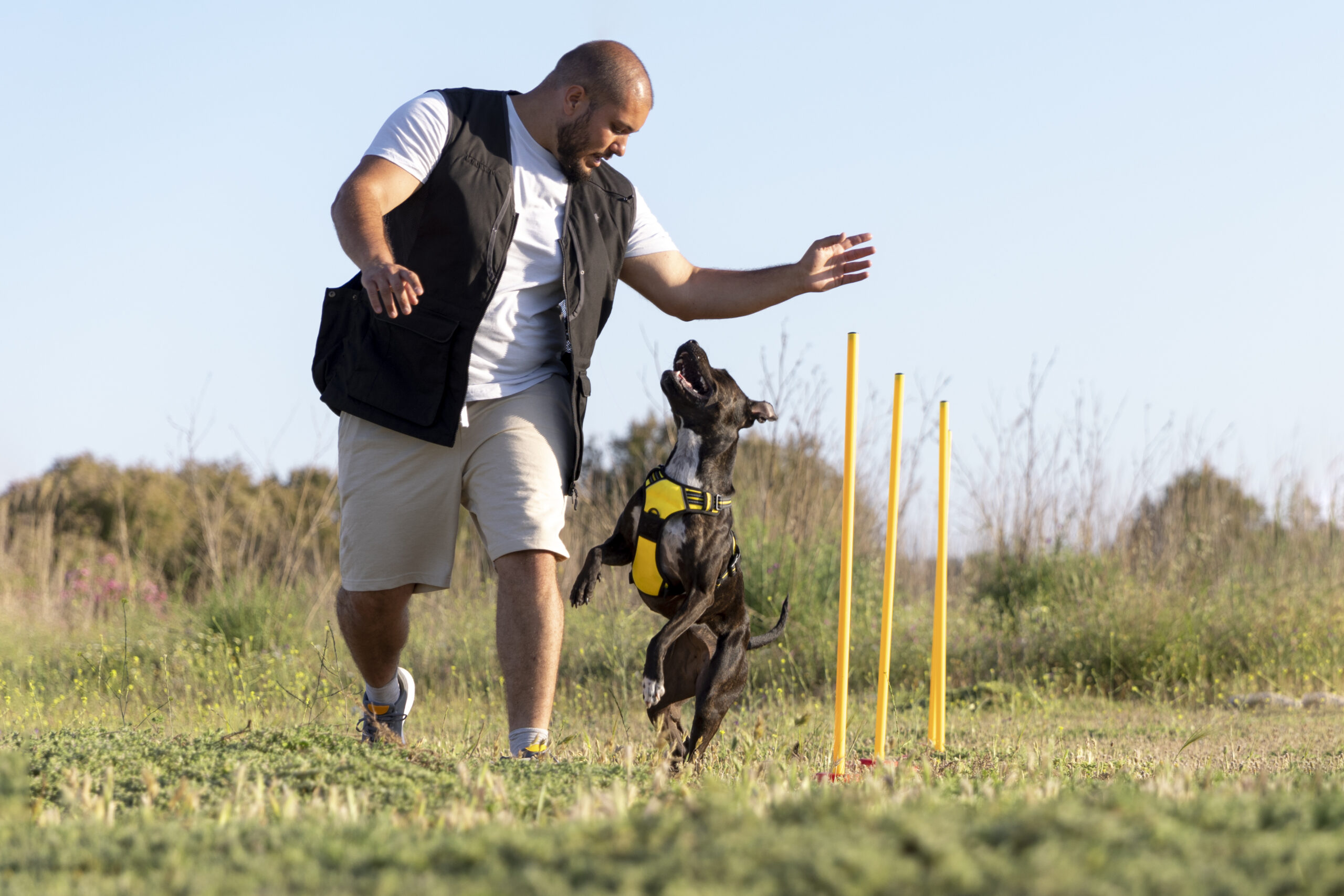Unlocking the Potential: The Power of Electronic Collar Training
Electronic Collar Training is a powerful tool that can significantly improve your dog’s obedience and behavior. In this guide, we explore the benefits, techniques, and best practices for using electronic collars effectively.

Introduction to Electronic Collar Training
Electronic collars, also known as e-collars, have revolutionized the way dog training is approached, offering a dynamic and responsive method to guide and correct canine behavior. These devices are engineered to deliver immediate feedback directly to the dog, enabling a clearer form of communication between the dog and the handler. This rapid feedback mechanism is crucial in reinforcing desired behaviors and correcting undesirable ones, making training more efficient and effective. The technology that powers electronic collars has seen considerable advancements, allowing for a wide spectrum of stimulation levels. This range ensures that the stimulation can be finely tuned to suit the sensitivity of the dog, from a gentle nudge that gets their attention to a more firm correction if required. Importantly, this technology is designed to be safe, avoiding any physical harm to the animal while still being highly effective.
High-quality electronic collars stand out not just for their corrective capabilities but also for their role in enhancing the safety and well-being of dogs. They facilitate a level of control and immediate obedience that is sometimes critical in preventing potentially dangerous situations. For instance, a dog’s ability to respond instantly to a recall command in an off-leash scenario can mean the difference between safety and peril. This immediate compliance can deter a dog from running into a busy street or engaging with dangerous wildlife, thereby acting as a lifesaving tool. Moreover, the precision offered by these collars ensures that the communication between the dog and the handler is clear, promoting a positive training experience and strengthening the bond between them. The design and functionality of high-quality e-collars reflect a deep understanding of canine behavior and training needs, underscoring their value in modern dog training practices.
How Electronic Collars Work
Electronic collars (e-collars) are sophisticated training tools that apply a controlled amount of electrical stimulation to the dog’s neck, serving as a form of communication to gain the dog’s attention or correct undesired behaviors. The technology behind these devices is designed to be humane and adjustable, ensuring that the sensation can range from a subtle tickle, barely noticeable to the dog, to a more noticeable pinch, contingent upon the level of stimulation selected by the trainer. This flexibility in adjustment is crucial as it allows the stimulation to be tailored to the dog’s sensitivity and tolerance, ensuring that the training process does not cause the dog any physical harm. The primary objective of using an e-collar is to guide the dog towards a behavioral correction or to reinforce commands, especially in situations where other forms of communication may be less effective.
The effectiveness of e-collar training hinges on the ability of the trainer to correctly identify the dog’s perception level, also known as the lowest level of stimulation that the dog can perceive. This requires a careful and methodical approach, starting with the lowest possible setting and gradually increasing the intensity until a minimal response, such as a slight movement of the ears or head, is observed in the dog. This level is then used as a baseline for training, providing a stimulus that is just enough to capture the dog’s attention without causing distress or discomfort. The goal is to utilize the e-collar as a means of reinforcing training commands and correcting behaviors by providing immediate feedback to the dog, thereby facilitating a faster and more effective learning process. By adjusting the level of stimulation to the specific needs and responses of the dog, trainers can ensure a humane and productive training experience that promotes better choices and learning outcomes.
![]() The Benefits of E-Collar Training
The Benefits of E-Collar Training
E-collar training offers a multitude of benefits that enhance the safety, control, and freedom of dogs, especially in off-leash situations. One of the most significant advantages of using electronic collars is the ability to establish reliable off-leash recall. This critical feature not only ensures that a dog can respond promptly to commands in potentially dangerous situations but also allows them the joy and freedom of exploring their surroundings without the constraint of a leash. Such training has proven effective in transforming dogs into obedient and confident pets, capable of navigating various environments safely. Off Leash K9 Training, renowned for its expertise in achieving off-leash obedience, highlights the efficacy of e-collar training in creating harmonious relationships between dogs and their owners, emphasizing the importance of control and safety in training [2].
Furthermore, e-collars present a viable training solution for sensitive breeds, debunking the myth that electronic collars are only suitable for hard-to-train or stubborn dogs. Through careful conditioning and a deep understanding of a dog’s reaction to the e-collar, training can be tailored to meet the needs of any breed, ensuring a positive and humane learning experience. The story of Zoey, a sensitive dog who had a negative initial experience with e-collar training, underscores the importance of professional guidance and the correct use of e-collars. With proper adjustment and a compassionate approach, Zoey’s training turned into a success story, illustrating that with the right techniques and understanding, e-collars can effectively train dogs without causing them harm. This approach aligns with the principle that when used correctly, e-collars serve as a safety measure rather than a punitive tool, ensuring obedience and preventing potentially dangerous situations, thereby fostering a safer environment for both dogs and their owners [3].
Safety and Efficacy in E-Collar Training
Ensuring the humane and effective use of electronic collars (e-collars) is central to fostering positive outcomes in dog training. Initiating training with e-collars at the lowest effective stimulation level is essential to gauge a dog’s sensitivity and response. Gradually adjusting the stimulation levels helps in achieving the desired behavior without causing undue stress or discomfort to the dog. This methodical approach aids in establishing a clear line of communication between the dog and the handler, which is vital for reinforcing correct behaviors and correcting undesired ones. The efficacy of e-collar training hinges on the handler’s ability to understand and interpret the dog’s reactions to stimuli, ensuring that the training experience remains positive and constructive.
The importance of selecting high-quality e-collars cannot be overstated. These devices offer a wide range of stimulation levels, providing the flexibility needed to tailor the training experience to the individual dog’s tolerance and learning curve. High-quality e-collars are designed to deliver a consistent and precise level of stimulation, which is critical for maintaining the dog’s focus and ensuring that the correction is perceived as intended. This precision not only enhances the safety and wellbeing of the dog but also significantly improves the effectiveness of the training process. Properly conducted e-collar training, supported by high-quality equipment, can transform the training experience, making it a powerful tool for achieving reliable and long-lasting behavioral improvements in dogs.

Professional Guidance and Training.
The role of professional trainers in e-collar training cannot be overstated, as they bring a wealth of experience and knowledge to the training process, ensuring that the use of electronic collars is both effective and humane. These experts recommend e-collars as crucial tools for communication, particularly in situations that demand immediate control or correction of the dog’s behavior. Their guidance is pivotal in achieving a balanced training regimen that combines the precise feedback provided by e-collars with positive reinforcement techniques. This blend not only enhances the dog’s learning experience but also fosters a positive relationship between the dog and its owner. Professional trainers are adept at assessing the individual temperament and response patterns of each dog, thereby tailoring the training approach to suit its unique needs. This personalized training strategy is instrumental in maximizing the effectiveness of e-collars, ensuring that they contribute positively to the dog’s behavioral development.
Furthermore, professional trainers play a critical role in educating dog owners on the proper use of e-collars, including finding the right stimulation level that motivates the dog without causing distress. For example, in the case of Zoey, a sensitive dog who initially had a negative experience with e-collar training, professional guidance was key in revisiting the training approach, ensuring that the e-collar was used effectively and compassionately. Trainers emphasize the importance of gradual conditioning and understanding the dog’s response to the stimulus, which are crucial steps in preventing negative outcomes and ensuring the welfare of the dog. By consulting with professionals, dog owners can make informed decisions about whether e-collar training is appropriate for their pet, taking into consideration the dog’s behavior, temperament, and the specific training goals. This collaborative approach between dog owners and professional trainers is essential for leveraging the benefits of e-collar training while upholding the highest standards of animal welfare.
Addressing Common Concerns and Misconceptions
Addressing common concerns about electronic collars (e-collars) is crucial for understanding their role in dog training. Despite the skepticism from some positive reinforcement trainers, the integration of e-collars with positive reinforcement methods can substantially improve training outcomes. E-collars offer a form of communication that, when used responsibly, does not harm the dog and instead fosters a learning environment where commands are clearly understood. This combination allows for a balanced approach to training that can correct unwanted behaviors while also rewarding desired actions, effectively enhancing the dog’s learning experience.
Moreover, the notion that e-collars represent a shortcut in training is a misconception. Far from being a quick fix, e-collars require a strategic approach to be effective. They serve as a safety measure, especially in critical situations where off-leash control is paramount. For instance, in off-leash environments, a dog’s safety can greatly depend on its immediate response to recall commands, a scenario where the precise and timely feedback from a high-quality e-collar can be lifesaving. The distinction between low-quality and high-quality e-collars is significant, as the latter offers more levels of stimulation, allowing for subtle and nuanced communication tailored to the dog’s sensitivity. This precision in communication ensures that training with e-collars, when done correctly, is humane and effective, promoting obedience and safety without compromising the welfare of the dog [3].
Real-life Success Stories and Case Studies
Real-life examples, such as the transformation of Zoey, a sensitive dog who benefited from correctly applied e-collar training, highlight the potential of e-collars to modify behavior without causing harm. Similarly, Off Leash K9 Training’s success stories underscore the effectiveness of e-collar training in achieving off-leash obedience and behavior modification, demonstrating significant improvements in both dogs’ and owners’ lives.
In conclusion, electronic collar training, when used correctly and under professional guidance, offers numerous benefits, from enhanced safety and control to the ability to train sensitive breeds responsibly. By understanding and respecting the principles of humane e-collar use, trainers and dog owners can leverage this technology to achieve reliable obedience and a stronger bond with their dogs.





